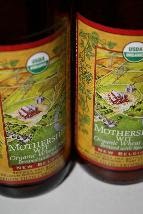
Allow me to digress momentarily. In my last entry I am quoted as saying: "The spicy pumpkin brews from autumn have been replaced with the maltier, darker, roastier, and stronger brews we have all come to love and expect..." while that may be true, I am going to take a step back to revisit autumn and review yet another pumpkin beer. But do not fear, this is not your average pumpkin ale. In fact it is quite the opposite. Allow me to forward you the video that originally piqued my curiosity regarding this collaboration brew: click here to view.
As the video says, the brew does not contain any of the spices typically found in pumpkin pie or a traditional pumpkin ale for that matter. This beer does contain roasted pumpkin puree, but it also contains roasted yams, toasted fenugreek, lemon verbena and birch bark. Does that not intrigue you? Each special ingredient (although I'm not entirely sure how) imparts its own special contribution to the beer. And I will attribute this late-season post to an opportunistic buy (as most of my beer purchases seemingly are). As I was searching for a late-night snack at the PCC in Fremont, I found myself perusing the beer aisle and the simple brown bottle and name: La Citrueille Celeste De Citracado (The Heavenly Pumpkin of Citracado) fairly leapt out at me and I was immediately obligated to buy. And so here we are.
This beer is part of Stone Brewing Company's: Collaboration 2011 Series. The three breweries that worked together on this beer: The Bruery (Orange County, CA), Elysian Brewing Company (Seattle, WA) and of course Stone Brewing Company (Escondido, CA). To read more about the collaboration series and where you might be able to find these unique and rare brews, please proceed here.
Any more information pertinent to this brew you might need to know? Need something more to entice you to seek this out? Maybe the fact that three of the West Coast's premier breweries (and more importantly brewmasters), two from CA and one from WA, collaborated on this one? Maybe that you won't easily find another beer with these ingredients brewed again? Maybe the fact that they will probably only ever brew this beer once? Ok, that should be enough reasons to go try and find this. Oh and just because I thought this was a fun fact: for you readers who are either French or fluent in the language, the citrueille in the name of the beer, which means pumpkin and should be spelled citrouille was misspelled intentionally in honour of the owner of The Bruery: Patrick Rue. Ok, now onto the beer!
Name: La Citrueille Celeste De Citracado
Category/Style: Pumpkin Ale
ABV: 5.00%
IBU: Unknown
OG: Unknown
FG: Unknown
Malt Type(s): Unknown
Hop Type(s): Warrior, NZ Motueca
Yeast Type: Unknown
Special Additives: Pumpkin, yams, fenugreek, lemon verbena, and birch bark
Bottled: October 12th, 2011
Bottle Size: 12 oz
Glassware: Pint glass or tumbler
Location Purchased: PCC, Fremont, Washington, USA
The Pour: Head is off-white to light brown, retention decent, some lacing. The beer is quite red, some coppery orange hues, dark amber.
The Nose: Lots of spice. Sweet toasty caramely notes. Some sweet potato, brown sugar, something very vegetable-like (pumpkin and yam?) and fresh about this brew. A little ripe banana. A little maple syrup. Buttered pecans, toasted wheat bread and dried grass. Ok, let's have a taste...
The Taste: I pick up the citrus notes from the lemon verbena on the first sip somewhere in the middle. A lot of toasty caramely notes. Nice bitter finish. A little sweet, but not overly so. Maybe a little sweet maple in there? Body on this one is light to medium. Mouthfeel is a little prickly. The carbonation is light to medium. Quite a bready dry finish with some lingering toasted notes. This beer is extremely well-balanced.
The Verdict: With these kinds of beers the question always remains, what kind of role did the pumpkin and yams play? I think these are both more detectable in the nose than in the beer itself. I absolutely abhor comments that suggest certain beers do not contain enough pumpkin flavour, or enough yam flavour. Have you ever tasted a plain pumpkin or yam? Probably not. The actual contribution to the beer is not in the flavour. It might contribute something to the colour, maybe some contribution to the nose, but flavourwise pumpkins and yams are bland without spice and sugar. Our perception is that pumpkins taste like pumpkin pie, and that is just all wrong. Go buy a can of plain pumpkin and then tell me if you'd like a beer that tastes like that. In any case, the beer in discussion is interesting to say the least. Did it blow my mind? No. But it was a well-balanced beer brewed by brewers who know how to brew good beer. The ingredients listed on the side of the bottle should be enough to entice the consumer: "Ale brewed with pumpkin, yams, toasted fenugreek, lemon verbena, and birch bark." I would actually liken this beer to an amber ale or brown ale, or perhaps some hybrid of the two. The flavours were subtle and at times difficult to discern. But it was not overly bitter, nor was it overly sweet, and the ingredients on the side of the bottle, while represented in one form or another, did not seem to throw-off the beer. It's a well-balanced, easy to drink sessionable brew worthy of a purchase. And frankly, that's the bottomline. Happy hunting!
Thanks for reading!
Zach



































.jpg)






.jpg)

.jpg)



+(size+edit).jpg)
.jpg)




